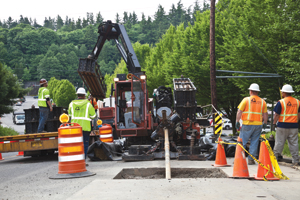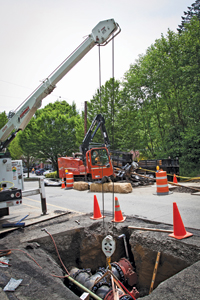Oregon Water District Upgrades Line Using HDD Technology
July 12, 2012
 The Tualatin Valley Water District (TVWD) maintains 769 miles of pipe and 25 covered reservoirs with a combined storage capacity of more than 59 million gals. TVWD provides quality water to nearly 200,000 customers in Washington County and portions of cities of Beaverton, Hillsboro and Tigard, Oregon.
The Tualatin Valley Water District (TVWD) maintains 769 miles of pipe and 25 covered reservoirs with a combined storage capacity of more than 59 million gals. TVWD provides quality water to nearly 200,000 customers in Washington County and portions of cities of Beaverton, Hillsboro and Tigard, Oregon. A segment of the Tualatin Valley Water District includes the West Hills of Portland. Comprised mainly of Basalt, the West Hills range rises up from the west side of the Willamette River Valley floor to over 1,000 ft in elevation. TVWD’s water transmission lines in this region are located along roadway corridors and contour the sloping elevations of the West Hills.
In 2012, Apex Directional Drilling LLC was contracted by the District to horizontally bore, pullback and install a new 1,500-ft segment of 20-in. (OD) HDPE pipe underneath a hill along Miller Road in Portland’s West Hills.
Traditional trench installations occur near the ground surface and follow the area’s elevations closely. HDD technology allows for underground installations in areas that were previously inaccessible, such as underneath elevated landscapes, as was the case with the Miller Road project. By utilizing the capabilities of HDD technology, Apex was able to install the new line segment directly through the Miller Road hill, at a much lower, uniform elevation. With the line segment upgrade, the District was able to increase gravity flow of water on Miller Road, resulting in increased efficiency within the water system.
 “HDD was an attractive solution for the TVWD engineering team due to directional drilling’s minimal disruption to the project site and small excavated footprint. This enabled the project to proceed on the side of the road with only minor disruptions to Miller Road’s heavy traffic flow,” said Nick Augustus, P.E., an engineering associate for the District.
“HDD was an attractive solution for the TVWD engineering team due to directional drilling’s minimal disruption to the project site and small excavated footprint. This enabled the project to proceed on the side of the road with only minor disruptions to Miller Road’s heavy traffic flow,” said Nick Augustus, P.E., an engineering associate for the District.The new 1,500-ft, 20-in. diameter segment was pulled back through a horizontal directionally drilled 36-in. bore at a depth of 60 ft from the hill’s crest. Each end of the new segment was then tied into the existing 16-in. ductile iron transmission line. The original segment was isolated from the new line with valves and left in place by the District for backup purposes.
Apex’s experienced management and field teams, coupled with their extensive inventory of equipment, allowed Apex to turnkey the entire project for the district. Apex Directional Drilling served as the general contractor on the project and executed all phases of the project. The Apex team engineered the bore profile, drilled the horizontal bore and executed the pullback. In addition, Apex coordinated the installation of a 42-in. steel starter casing, as well as the pipe fusion, hydrostatic pressure testing and water treatment of the new line segment. Lastly, Apex performed the tie-in of the new segment to the system.
Apex’s fleet of drills consist of Ditch Witch JT100 and JT3020 All Terrain Directional Drills. For the project, a JT100 was chosen to perform the horizontal bore and pullback. The 100,000-lb JT100 provided the necessary power to complete the 36-in. ream and handle the demanding pullback weight of the 1,500-ft segment of 20-in. HDPE pipe. A reclaimer was employed for the project to recycle the drilling fluids during the boring process which helped to reduce the amount of water and materials necessary to complete the bore. Lastly, Apex’s in-house inventory of complementary construction equipment necessary to power the project such as trailers, excavators and vacuum pumps were utilized throughout the water line upgrade project.
 Sean Hogan, senior director of HDD technical support for Apex, guided the execution of the 36-in. horizontal bore and 20-in. HDPE pipe pullback. Hogan brings years of highly specialized HDD experience to the Apex team and was responsible for managing all technical aspects of the project. “The boring process was challenging due to the varying substrates encountered. The hill was comprised of a top layer of clay, followed by a Basalt layer, and the center was comprised of sandy silt,” said Hogan.
Sean Hogan, senior director of HDD technical support for Apex, guided the execution of the 36-in. horizontal bore and 20-in. HDPE pipe pullback. Hogan brings years of highly specialized HDD experience to the Apex team and was responsible for managing all technical aspects of the project. “The boring process was challenging due to the varying substrates encountered. The hill was comprised of a top layer of clay, followed by a Basalt layer, and the center was comprised of sandy silt,” said Hogan. Hogan closely monitored the entire boring process and had to make several alterations as different substrates where encountered, including: drilling fluid viscosity adjustments, implementation of mud motors and the employment of various cutting heads.
After successfully completing the horizontal bore, the 1,500-ft segment of HDPE pipe was field fused, hydrostatically pressure tested and positioned for the pullback by the Apex field team.
Another challenging aspect of the project occurred during the pullback phase. Due to the length, weight and diameter of the 20-in. HDPE pipe, precise amounts of pipe ballast weight had to be added to achieve neutral buoyancy to ensure a smooth pullback.
Apex’s in-house mechanical and plumbing teams completed the installation by performing the water line tie-in. Two 16-in. diameter, 5,000-lb butterfly valve configurations were installed at each end of the new segment. The valves were then joined with TVWD’s transmission lines and the original line segment was connected back to the system.
 Apex regional operations manager Scott Gagner served as project manager for the water line upgrade. Gagner was responsible for managing operations and Apex’s field team during all phases of the TVWD water line upgrade project. “Apex is more than a drilling company. We offer complete integrated services that allow for projects such as the Miller Road project to be completed on time and on budget,” he said. “Apex has the unique ability to serve as the general contractor and execute all phases of the project. This eliminates any potential unknowns that can sometimes result in time delays and cost overruns when multiple subcontractors are brought onto a project.”
Apex regional operations manager Scott Gagner served as project manager for the water line upgrade. Gagner was responsible for managing operations and Apex’s field team during all phases of the TVWD water line upgrade project. “Apex is more than a drilling company. We offer complete integrated services that allow for projects such as the Miller Road project to be completed on time and on budget,” he said. “Apex has the unique ability to serve as the general contractor and execute all phases of the project. This eliminates any potential unknowns that can sometimes result in time delays and cost overruns when multiple subcontractors are brought onto a project.”The TVWD Miller Road water line upgrade project serves as another example of the advantages and new opportunities that horizontal directional drilling provides. With HDD’s capabilities, areas previously thought impossible to perform underground installations are now within reach. By utilizing HDD technology, the Tualatin Valley Water District was able to increase their water system’s efficiency, allowing them to better serve their customers — a win-win for the District and the HDD industry.
David Ladd is a technical writer for Apex Directional Drilling.
